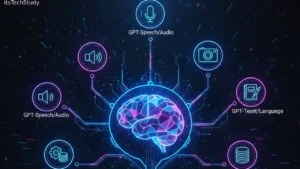Introduction: Why Conversational AI Matters More Than Ever
Over the last decade, technology has rapidly evolved toward one core goal: creating seamless, human-like interactions between people and digital systems. Earlier digital tools were rigid – apps, websites, and machines followed predefined commands and lacked natural communication. Today, users expect more. They want technology that understands them, responds smoothly, and adapts to their needs.
This expectation, combined with massive advancements in Natural Language Processing (NLP), machine learning, and neural networks, has given rise to one of the most transformative technologies of the modern digital world: Conversational AI.
From customer support chatbots and voice assistants to automated workflows and personalized shopping experiences, Conversational AI is reshaping how businesses operate and how users interact with technology. As industries adopt this technology at scale, new challenges also emerge – accuracy, reliability, data privacy, and maintaining natural conversational flow.
This comprehensive guide explores everything about Conversational AI: how it works, its components, benefits, limitations, use cases, comparisons, FAQs, and the future direction. Written in a natural, human-like tone, this article provides deep insights while remaining accessible, SEO-optimized, and AdSense friendly.
What Is Conversational AI?
Conversational AI refers to intelligent systems that can understand, process, and respond to human language – either written or spoken – in a natural, conversational manner.
Unlike traditional chatbots that follow strict rules and scripts, conversational AI can learn from data, identify intent, generate meaningful responses, and hold dynamic, multi-turn conversations.
Key Technologies Behind Conversational AI
Conversational AI typically uses a combination of:
- Natural Language Processing (NLP)
- Natural Language Understanding (NLU)
- Natural Language Generation (NLG)
- Machine Learning (ML)
- Deep Learning
- Speech Recognition
- Text-to-Speech (TTS)
- Large Language Models (LLMs)
These elements work together to allow the system to understand context, detect tone, provide relevant answers, and improve over time.
How Conversational AI Works: Step-by-Step
1. Input Processing
The system receives text or voice input from the user.
2. Natural Language Understanding (NLU)
Analyzes the input and identifies:
- Intent
- Entities
- Context
3. Dialogue Management
Determines the appropriate response based on:
- Conversation history
- User profile
- Business rules
- AI reasoning
4. Natural Language Generation (NLG)
Generates a natural, human-like response.
5. Output Delivery
Responds via:
- Text (chatbots)
- Speech (voice assistants)
- Multimodal outputs (rich UI chatbots)
Types of Conversational AI
1. Rule-Based Chatbots
- Follow predefined scripts
- Limited understanding
- No learning ability
2. AI-Powered Chatbots
- Understand context
- Learn from interactions
- Provide personalized responses
3. Voice Assistants
Examples include:
- Smart home devices
- Mobile voice assistants
- Automotive voice interfaces
4. Multimodal Conversational AI
Combines voice, text, gestures, images, and UI elements for enhanced interaction.
Why Conversational AI Is Becoming Essential
Businesses across industries are adopting conversational AI to streamline operations and improve customer experiences. Key reasons include:
1. Changing User Behavior
People prefer quick, conversational interactions rather than clicking through complex menus.
2. Rising Automation Demand
Organizations want to reduce operational costs and improve efficiency.
3. 24/7 Support Expectation
Customers expect round-the-clock responses.
4. Better Personalization
AI-powered conversations adapt to user behavior, history, and preferences.
Table: Rule-Based Bots vs. Conversational AI Bots
| Feature | Rule-Based Chatbots | Conversational AI |
|---|---|---|
| Understanding | Keyword-based | Contextual, intent-driven |
| Learning Ability | No | Yes |
| Response Quality | Scripted | Dynamic, human-like |
| Use Cases | Simple FAQs | Complex, multi-turn conversations |
| Accuracy | Limited | High accuracy with training |
| Integration | Basic | Advanced (CRM, apps, workflows) |
Benefits of Conversational AI
1. Enhanced Customer Experience
Conversational AI provides fast, helpful, and natural interactions.
2. Cost Efficiency
Reduces the need for large support teams.
3. Scalability
Can handle thousands of conversations simultaneously.
4. 24/7 Availability
Never sleeps or gets overwhelmed.
5. Increased Engagement
Interactive and dynamic conversations retain user attention.
6. Better Insights
AI analyzes conversations to identify trends and customer needs.
Pros and Cons of Conversational AI
Pros
- Improves customer experience
- Scales without increasing costs
- Reduces human workload
- Provides quick and accurate answers
- Supports personalization
- Integrates with multiple systems (CRM, ERP, CMS)
Cons
- Requires high-quality training data
- Can misunderstand ambiguous queries
- Needs ongoing optimization
- May struggle with highly emotional or complex human contexts
Key Use Cases of Conversational AI
1. Customer Support
AI-driven chatbots resolve issues instantly.
2. E-commerce
Product suggestions, order tracking, and personalized shopping.
3. Healthcare
Appointment scheduling, symptom checking, virtual assistance.
4. Banking & Finance
Balance inquiries, fraud detection alerts, transaction updates.
5. Education
AI tutors, doubt-solving bots, interactive learning platforms.
6. Enterprise Automation
Employee help desks, HR automation, knowledge management.
Conversational AI in Customer Service: A Deeper Look
Customer service is one of the biggest beneficiaries of conversational AI. Traditional call centers suffer from:
- Long wait times
- High operational costs
- Inconsistent responses
- Limited availability
Conversational AI solves these issues by:
- Providing instant responses
- Automating repetitive queries
- Assisting human agents
- Routing customers efficiently
Conversational AI vs. Generative AI: Are They Different?
Though related, they serve different purposes:
Conversational AI
- Focuses on dialogue
- Uses intent detection
- Structured for communication tasks
Generative AI
- Creates content (text, images, code, etc.)
- More creative and open-ended
However, modern conversational AI often uses generative AI models for natural responses.
Important Features to Look for in a Conversational AI Platform
1. Multi-language support
2. Omni-channel integration
3. Analytics and reporting
4. Sentiment analysis
5. Personalization engine
6. Training and feedback tools
Challenges in Implementing Conversational AI
1. Understanding Human Emotions
AI still struggles with sarcasm, humor, and feelings.
2. Privacy and Security
Handling user data responsibly is crucial.
3. Miscommunication
AI can misinterpret vague or ambiguous sentences.
4. Training Data Quality
Poor data = inaccurate responses.
5. Integration Complexity
Advanced implementations require technical expertise.
Future of Conversational AI
The future promises exciting developments:
1. Emotion-Aware AI
Understanding tone and emotional cues.
2. Hyper-Personalized Assistants
AI that adapts to individual behavior patterns.
3. Multimodal Communication
Combining speech, text, images, and gestures.
4. Enterprise Automation
AI-driven workflows revolutionizing business operations.
5. Voice Everywhere
Cars, workplaces, homes – AI voice interfaces will be universal.
Conclusion: Why Conversational AI Is the Future of Digital Interaction
Conversational AI is no longer a futuristic concept – it is a mainstream technology powering the world’s digital experiences. From customer support and e-commerce to healthcare and education, its impact is profound and expanding. As NLP becomes more advanced and AI models continue to evolve, conversational AI will deliver richer, more personalized, and more intuitive interactions.
For businesses, adopting conversational AI is not just an option – it is a competitive advantage. When implemented strategically, it reduces cost, boosts engagement, enhances customer satisfaction, and unlocks new automation opportunities.
The future belongs to systems that can understand and communicate like humans – and conversational AI is leading the way.
FAQs About Conversational AI
Q1: Is conversational AI the same as a chatbot?
Ans: No. A basic chatbot follows rules, while conversational AI uses machine learning, NLU, and context understanding to produce intelligent, dynamic responses.
Q2: Can conversational AI replace human agents?
Ans: It can automate repetitive tasks, but complex or emotionally sensitive issues still require human involvement.
Q3: Is conversational AI hard to implement?
Ans: Basic AI systems are easy to deploy, but advanced, personalized implementations may require data, training, and integration support.
Q4: Does conversational AI support multiple languages?
Ans: Yes. Modern platforms support dozens of languages using multilingual NLP models.
Q5: Can conversational AI improve sales?
Ans: Absolutely. It helps users with product recommendations, simplifies shopping, and offers real-time assistance, boosting conversions.
Q6: Is conversational AI safe?
Ans: Yes, if implemented with proper data encryption, access control, and compliance standards.











No Comments Yet
Be the first to share your thoughts.
Leave a Comment